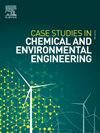气流和N/P比对普通小球藻去除CO2的影响:低成本传感器实时监测研究
Q1 Environmental Science
Case Studies in Chemical and Environmental Engineering
Pub Date : 2025-05-19
DOI:10.1016/j.cscee.2025.101239
引用次数: 0
摘要
气候变化是我们在全球面临的最大挑战之一,减少二氧化碳排放是最紧迫的行动之一。在这项研究中,我们探索了一种利用微藻(小球藻)从空气中捕获二氧化碳的替代方法,采用arduino控制的生物过滤系统,配有MQ-135和TESTO 535等可访问传感器。我们测试了不同的气流速率(50、75和100 L /小时)和营养成分组合(氮磷比分别为0、108.33和216.67),以确定最有效的条件。与其他研究不同的是,我们将二氧化碳浓度、温度和光线等变量的实时监测集成在一个模块化的、易于适应的系统中。在流速为100 L/h、氮磷比为216.67的条件下,捕集效率为34.88%,日产量接近1 g/L。这一建议表明,将可获得的技术和生物技术结合起来,开发有效、经济和可复制的解决方案,以帮助缓解气候变化是可能的。本文章由计算机程序翻译,如有差异,请以英文原文为准。
Impact of airflow and N/P ratio on CO2 removal by chlorella vulgaris: A study with real-time monitoring using low-cost sensors
Climate change represents one of the greatest challenges we face globally, and reducing carbon dioxide (CO2) emissions is among the most urgent actions. In this study, we explored an alternative approach using microalgae (Chlorella vulgaris) to capture CO2 from the air, employing an Arduino-controlled biofiltration system with accessible sensors such as the MQ-135 and TESTO 535. We tested different airflow rates (50, 75, and 100 L per hour) and nutrient combinations (N/P ratios of 0, 108.33, and 216.67) to identify the most efficient conditions. Unlike other studies, we integrated real-time monitoring of variables such as CO2 concentration, temperature, and light within a modular, easily adaptable system. The best results were achieved with a flow rate of 100 L/h and an N/P ratio of 216.67, yielding a capture efficiency of 34.88 % and a daily productivity of nearly to 1 g/L. This proposal demonstrates that it is possible to develop effective, economical, and replicable solutions that combine accessible technology and biotechnology to help mitigate climate change.
求助全文
通过发布文献求助,成功后即可免费获取论文全文。
去求助
来源期刊

Case Studies in Chemical and Environmental Engineering
Engineering-Engineering (miscellaneous)
CiteScore
9.20
自引率
0.00%
发文量
103
审稿时长
40 days
 求助内容:
求助内容: 应助结果提醒方式:
应助结果提醒方式:


